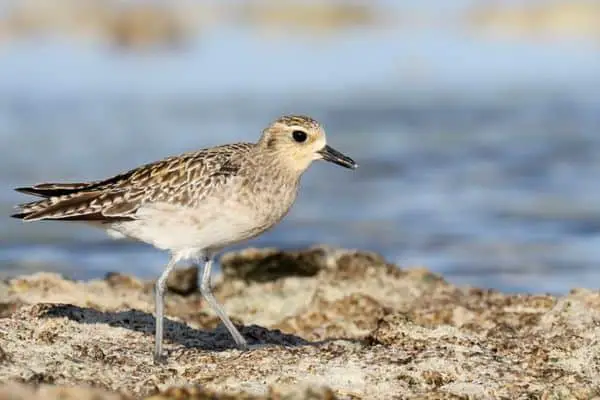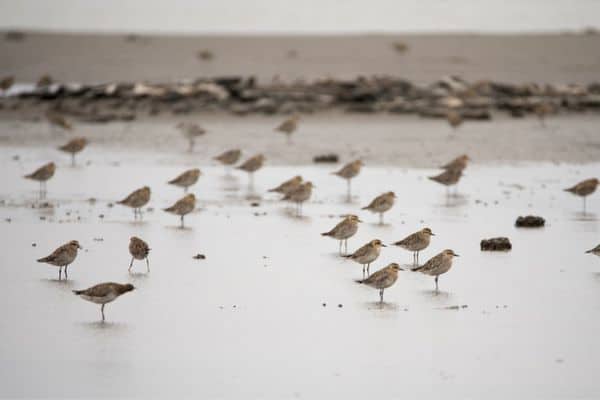Hawaii is known as the Aloha State, is an archipelago consisting of eight main islands: Hawaii (also known as the Big Island), Maui, Oahu, Kauai, Molokai, Lanai, Niihau, and Kahoolawe. Hawaii’s tropical climate is drier between May and October and wetter between November and April.
From the language, ʻŌlelo Hawaiʻi, to hula dancing and music, Hawaii is steeped with cultural heritage. It’s also home to a wide array of plant and animal species, including birds like plovers.
Plovers are a group of small to medium-sized shorebirds that belong to the family Charadriidae. These birds can often be seen along shorelines, tide pools, estuaries, and other coastal areas. Plovers can be found throughout most of the world, including some of the polar regions.
There are more than 60 different plover subspecies, but only the Pacific Golden Plover can be found on the Hawaiian Islands. This article will tell you more about this species in Hawaii and where you can find them.
Plovers in Hawaii
In Hawaii, there is only one species of plover: the Pacific Golden-Plover. Let’s learn about them and what makes them unique.
Pacific Golden-Plover

Scientific Name: Pluvialis Fulva
The Pacific golden plover, known as the kōlea in Hawaiian, is a migratory bird found on the Hawaiian Islands. These shorebirds journey from their breeding grounds in Arctic regions, particularly Alaska, to spend their winters in Hawaii. They usually arrive on the islands in August and leave around April or May.
During their visit, they can be seen in several places across Hawaii, including beaches, grasslands, golf courses, and farm fields. Bird watchers have reported sitings of the Pacific golden plover on all of Hawaii’s eight main islands, as well as a few of the smaller islands. Read on for more details about the only plover species in Hawaii.
Physical Characteristics

Pacific golden plovers are medium-sized shorebirds somewhere between the size of a robin and a crow. On average, these birds are between 9 and 10 inches long. They have a compact and streamlined body shape, with a short neck and legs.
Their bills are relatively short and stout, designed for capturing small invertebrates from the ground. During the winter months, when you can see these birds in Hawaii, they typically have yellowish bodies with brown speckles.
However, during the breeding season in the spring, they lose their more subdued feathers, and their plumage becomes more speckled with more white mixed in. Their face, belly, and wingtips become black.
Juvenile Pacific golden plovers look a bit different than the adults. Their plumage is more mottled and spotted, with a mix of browns, blacks, and whites. As they mature, their plumage gradually transitions to the adult coloration.
Unlike a lot of other bird species, Pacific golden plovers are not sexually dimorphic, which means there is not a lot of difference between how the males and females look. During the winter, it is difficult to tell the two apart, but during mating season, the males do have more vibrant coloring.
Behavior and Diet

Pacific golden plovers are primarily insectivorous and feed on a wide range of prey, including insects, worms, crustaceans, and mollusks. They forage by pecking at the ground or running swiftly to catch their prey.
These plovers are known for their agility and speed, often seen performing quick dashes and aerial maneuvers during feeding. They are also protective of their feeding territories and may display aggressive behavior towards other birds or animals that encroach upon their space.
Vocalizations
Pacific golden plovers are known for their distinctive whistling calls, which can often be heard as they move around their foraging areas. These whistles can carry over long distances, allowing individuals to communicate with each other and maintain contact.
Vocalizations are important for establishing and defending territories during the wintering period in Hawaii. Male plovers may use their calls to proclaim and protect their feeding territories, warding off intruders and signaling ownership. They often vocalize from elevated perches to make their call more easily heard.
Pacific golden plovers also use vocalizations during the breeding season to attract mates and establish pair bonds. The male may perform elaborate courtship displays while vocalizing, including flying displays and aerial acrobatics. These displays, accompanied by vocalizations, help demonstrate the male’s fitness and attract a female partner.
Breeding

This species breeds between May and June on the Arctic tundra. The female typically lays four off-white eggs with brown or white spots, which are incubated by both parents.
Both parents take care of the young after they hatch around 26 days later. They care for them until the group is ready to migrate for the winter.
Journey to Hawaii
Pacific golden plovers are known for their impressive long-distance migrations. They breed in the Arctic tundra regions during the spring and then embark on a journey of thousands of miles to their wintering grounds in places like Hawaii, Australia, and other Pacific islands.
They use celestial cues and landmarks to migrate these great distances. Hawaii is a critical wintering destination for this species. Every year, large numbers of plovers arrive in the Hawaiian Islands around August, staying until April or May.




